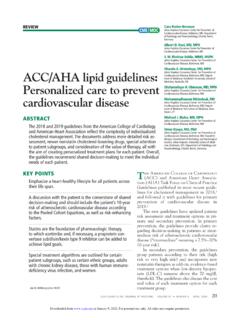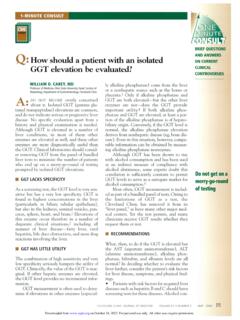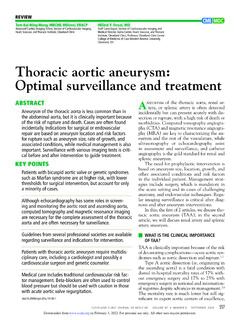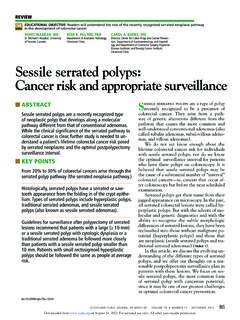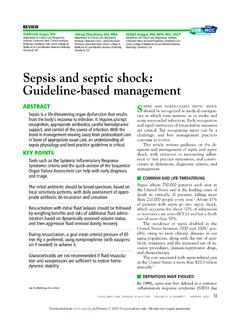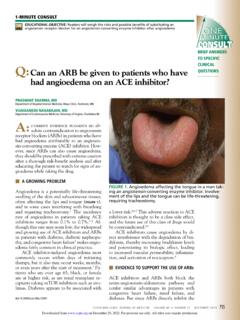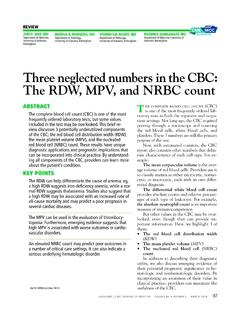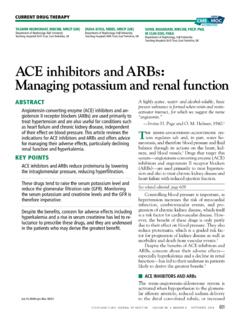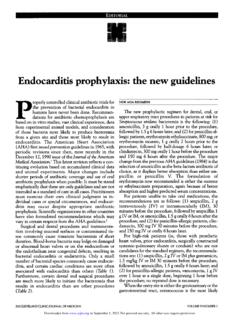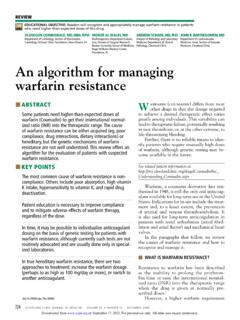Transcription of TaRek i. abu-Rajab TaMiMi, MD jaMil Y. abuzeTun, MD ...
1 Ribhi hazin, MDHarvard University, Faculty of Arts & Sciences, Cambridge, MARecognizing and treating cutaneous signs of liver diseaseabstract Cutaneous changes may be the first clue that a patient has liver disease. Recognizing these signs is crucial to diagnosing liver conditions early. Here we describe the spectrum of skin manifestations that may be found in various liver Points Pruritus due to liver disease is particularly resistant to therapy. Cholestyramine (Questran) 4 g/day, gradu-ally increased to 24 g/day, is one option. If the pruri-tus does not respond or the patient cannot tolerate cholestyramine, rifampin (Rifadin) can be angiomas, Bier spots, and paper-money skin are all superficial vascular problems that may be related to liver lesions often accompany alcoholic cirrhosis and have been detected in up to 43% of people with chronic alcoholism.
2 The combination of spider angiomas, palmar erythema, and Dupuytren contracture is common in alcoholic porphyria cutanea tarda is associated with liver disease in general, recent studies show that pa-tients with hepatitis C are at particularly high CLINIC JOURNAL OF MEDICINE VOLUME 76 NUMBER 10 OCTOBER 2009 599 Dysfunction in the body s second larg-est organ, the liver, often yields changes in the body s largest organ, the skin. If we can recognize these manifestations early, we are better able to promptly diagnose and treat the underlying liver disease, as well as the skin le-sions. The liver has many jobs: synthesizing pro-teins such as clotting factors, complements, and albumin; neutralizing toxins; and metabo-lizing lipids and carbohydrates.
3 Insults to the liver can compromise any of these functions, affecting visceral organs, joints, gastrointesti-nal tissues, and the skin. Dermatologic signs of specific liver diseases include alopecia and vitiligo associated with autoimmune hepatitis, and xanthelasma in chronic cholestatic liver disease. This article reviews the important cutane-ous manifestations of specific liver diseases. We focus first on skin conditions that may represent liver disease, and then we discuss several major liver diseases and their typical cutaneous and Hyperbilirubinemia Jaundice, the cardinal sign of hyperbilirubine-mia, is usually recognizable when serum biliru-bin levels exceed or mg/dL.
4 The color of the skin typically reflects the severity of the bilirubin ,2 Jaundice due to mild hy-perbilirubinemia tends to be yellowish, while that due to severe hyperbilirubinemia tends to be brownish (Figure 1). Establishing whether the excess bilirubin is conjugated or unconjugated gives a clue as to whether the cause is prehepatic, intrahepatic, or 8 One of the liver s main func- i. abu-Rajab TaMiMi, MDDepartment of Gastroenterology and Hepatology, Cleveland ClinicjaMil Y. abuzeTun, MDDepartment of Internal Medicine, Creighton University Medical Center, Omaha, NEnizaR n. zein, MDMikati Foundation Endowed Chair in Liver Diseases; Chief, Section of Hepatol-ogy; Medical Director of Liver Transplan-tation, Department of Gastroenterology and Hepatology, Transplantation Center, Cleveland ClinicEDUCATIONAL OBJECTIVE: Readers will be familiar with common skin signs of liver diseaseCREDITCME on May 28, 2022.
5 For personal use only. All other uses require from 600 CLEVELAND CLINIC JOURNAL OF MEDICINE VOLUME 76 NUMBER 10 OCTOBER 2009tions is to conjugate bilirubin into a secretable form. Prehepatic causes of jaundice include hemolysis and ineffective erythropoiesis, both of which lead to higher levels of circulating unconjugated Intrahepatic causes of jaundice can lead to both unconjugated and conjugated ,8 Posthepatic causes such as bile duct obstruction primarily result in conjugated and prurigo nodularis Pruritus can be multifactorial or the result of a specific dermatologic or systemic A thorough history and physical examination are warranted to rule out hepatic or systemic causes of The liver neutralizes toxins and filters bile salts.
6 If its function is impaired, these materi-als can accumulate in the body, and deposition in the skin causes irritation and ,12 In cholestatic liver disorders such as primary sclerosing cholangitis and obstructive gall-stone disease, pruritus tends to be generalized, but worse on the hands and Although the severity of pruritus is not directly associated with the level of bile salts and toxic substances, lowering bile salt levels can mitigate Treatment. Pruritus due to liver disease is particularly resistant to therapy. In a strategy described by Mela et al for managing pruritus in chronic liver disease,14 the initial treatment is the anion exchange resin cholestyramine (Questran) at a starting dose of 4 g/day, gradually increased to 24 g/day in two doses at mealtimes.
7 If the pruritus does not respond adequately to cholestyramine or the patient cannot tol-erate the drug, then the antituberculosis drug rifampin (Rifadin) can be tried. Rifampin promotes metabolism of endogenous prurito-gens and has been effective against cholestatic pruritus when started at 150 mg/day and in-creased up to 600 mg/day, depending on the clinical Third-line drug therapies include opioid antagonists such as naltrexone (ReVia) and nalmefene (Revex).14,15 Plasmapheresis can be considered if drug therapy Experimental therapies include albumin dialysis using the molecular adsor-bent recirculating system (a form of artificial liver support), antioxidant treatment, and bright-light Liver transplantation, when appropriate, also resolves cholestatic nodularisPrurigo nodularis, distinguished by firm, crusty nodules, is associated with viral infec-tions (eg, hepatitis C, human immunodefi-ciency virus)
8 , bacterial infections, and kidney ,18 The lesions are intensely pru-ritic and often lead to persistent scratching, excoriation, and, ultimately, diffuse Treatment. Although the exact cause of prurigo nodularis is not known and no cure ex-ists, corticosteroid or antihistamine ointments control the symptoms in most patients with Low doses of thalidomide (Thalo-mid), a tumor necrosis factor antagonist, have also been used safely and ,19superFicial vascular signs spider angiomasSpider angiomas, or spider nevi, are collec-tions of dilated blood vessels near the surface of the They appear as slightly raised, small, reddish spots from which fine lines radi-ate outward, giving them a spider-like appear-ance (Figure 2).
9 21,22 Spider angiomas can occur anywhere on the body, but they occur most often on the face and the ,23 A key feature is that skin color typically reflects the severity of the jaundiceFigure 1. Characteristic yellowish discolor-ation of the sclera in the eye of a patient with end-stage liver signs of liVer disease on May 28, 2022. For personal use only. All other uses require from CLEVELAND CLINIC JOURNAL OF MEDICINE VOLUME 76 NUMBER 10 OCTOBER 2009 601 HaZin and colleaguesthey disappear when pressure is applied and reappear when pressure is ,24 Biopsy is rarely necessary for diagnosis.
10 These lesions occur with elevated estro-gen levels, such as in cirrhosis, during estrogen therapy, or during 28 Although spi-der angiomas are common in pregnant women and in children, adults with spider angiomas deserve a workup for liver Given their innocuous nature and asymp-tomatic course, spider angiomas themselves require no medical spotsBier spots are small, irregularly shaped, hypo-pigmented patches on the arms and legs. They are likely due to venous stasis associated with functional damage to the small vessels of the Since Bier spots are a sign of liver disease, they must be distinguished from true pigmen-tation disorders.
